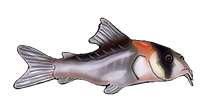At first glance, some of you may think that I'm "breaking the golden rule", and asking you how I can distinguish the difference between my male and female fish. No sir! That is not the case, so please don't throw tomatoes or rotten eggs at me.
Here is my situation. I have never owned Corydoras Pygmaeus before. I recently purchased 24 of them, from a seller who said that they were wild-collected, and that he had kept them in quarantine for AT LEAST 60 days. He assured me that they would be very healthy specimens.
I must say that I was quite pleased when they arrived. There were no D.O.A.'s, all of them appeared to be very frisky, had good color, good fins, swam around and explored their new home, and had no visible imperfections of any kind. When I began to feed them the next day, they ate. I've worked hard to treat them well, BUT I ADMIT THAT I AM NO EXPERT ON THESE FISH. So in addition to the question(s) that I'll ask, please feel free to tell me, if you think I could do something better than I'm doing.
These Pygmaeus are presently in a 10-gallon tank, with no substrate. (I plan to use fine substrate in their breeding tank some day, but I was hoping to avoid it at this time.) There is a large sponge filter, an airstone, (2) coconut caves with Java Moss, and driftwood in their tank. I feed them frozen B.B.S., decapped brine shrimp eggs, New Life Spectrum (ground fine), Banana Worms, Walter Worms, and Micro Worms. As far as I can tell, they are very healthy, and doing well.
Now --- to the crux of the matter. My goal has been to "raise them up", make them healthy, get them to the point of sexual maturity, and then pursue a breeding program with them. In order to do that, I've realized that at some point I would need to know that they are sexually mature, and I'd need to be able to determine which are males and which are females. Once I can do that, I would like to move a group of them to a breeding tank, and then go from there.
I believe I have seen them become slightly larger during the 6 weeks that I've had them, but that is difficult to determine, because these are small critters! So here is my main question, (plus a bonus question or two):
--How can I know if these fish are sexually mature?
This is how I've tried to think it through: With regard to their age, I assume that they were born in the river, and at some point, they were caught and sold to someone. At some point, they ended up in the hands of the person from whom I purchased them. Assuming that he is correct and truthful, he had them for at least two months. Based upon what I've seen, I have no reason to doubt him. Now I've had them for 6 weeks. I could add all of that up, but I don't know how old they were when they were taken from the river, so that doesn't help much.
--With regard to trying to determine sexual maturity from appearances, I can tell you this: If I look at them closely, I can see that there is a distinct size difference between the largest ones, and the smallest ones. The largest ones are *perhaps* 3 mm bigger than the smallest. And if it's not my imagination, I believe that the largest ones are, in fact, more "robust" or plump, than the smallest ones. So -- is it reasonably safe for me to assume that the biggest ones are females, and the smallest ones are the males, at this point?
And if that is the case, then does the fact that I can now determine males from females, NECESSARILY mean that they are sexually mature at this point?
REMEMBER PLEASE that I don't want to be guilty of asking how to determine the boys from the girls. I don't want to be banned from this site.
If anyone feels the need to provide suggestions/corrections regarding the other parts of my approach, please do so. I am in this to learn, so constructive criticism is always welcome. Thank you, everyone, and have a great day.




